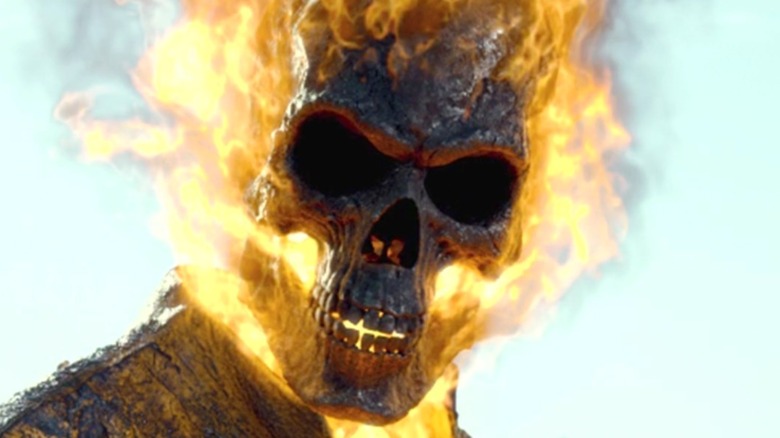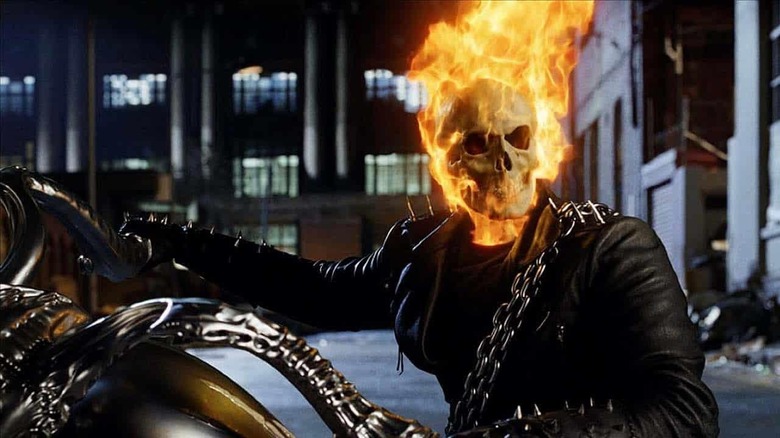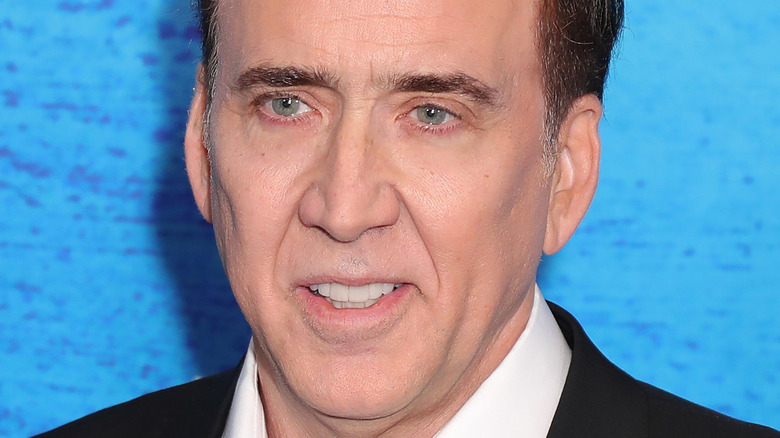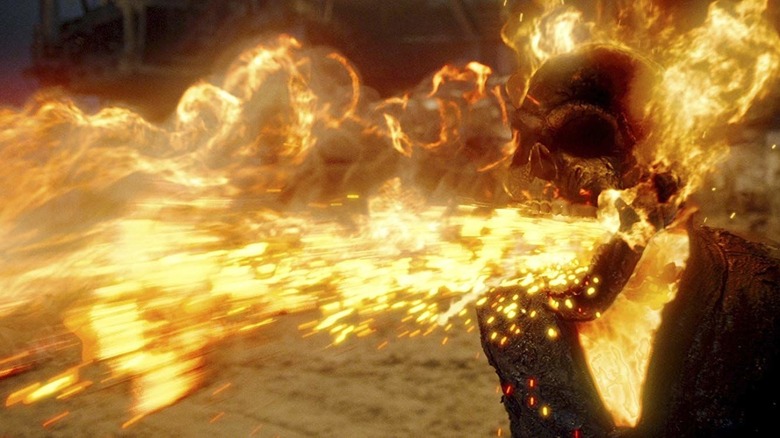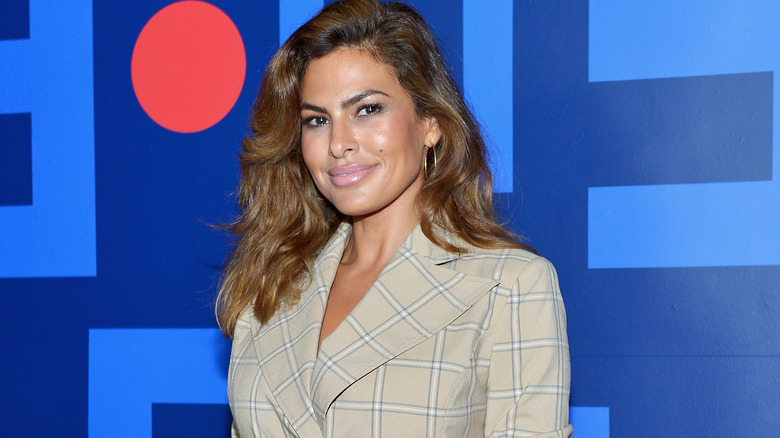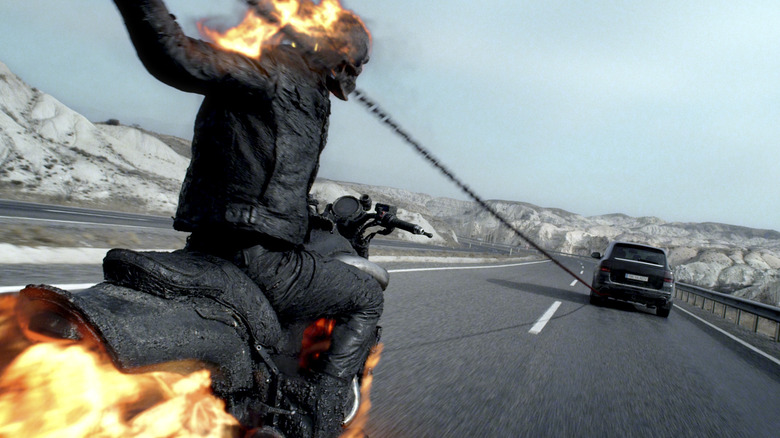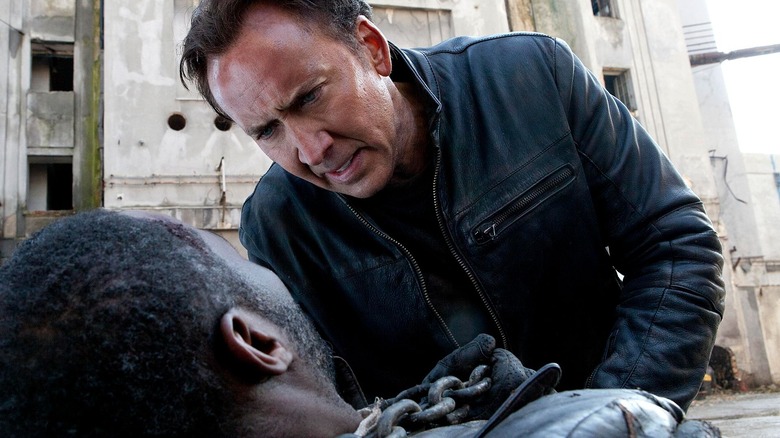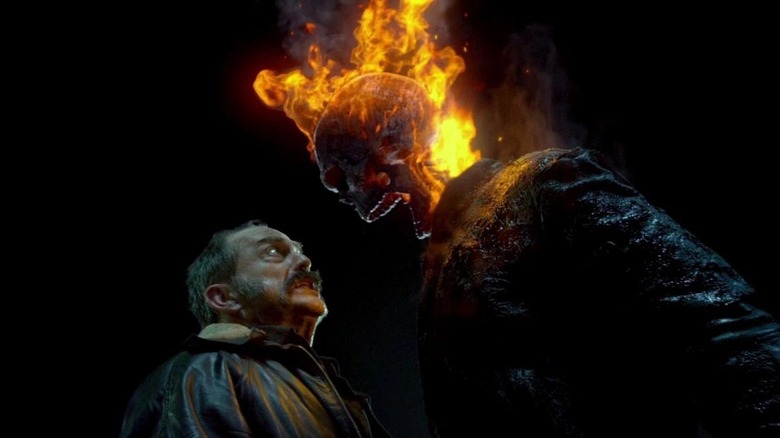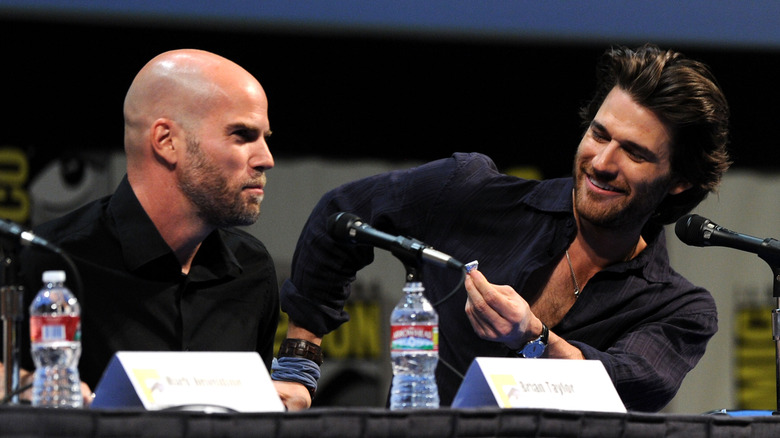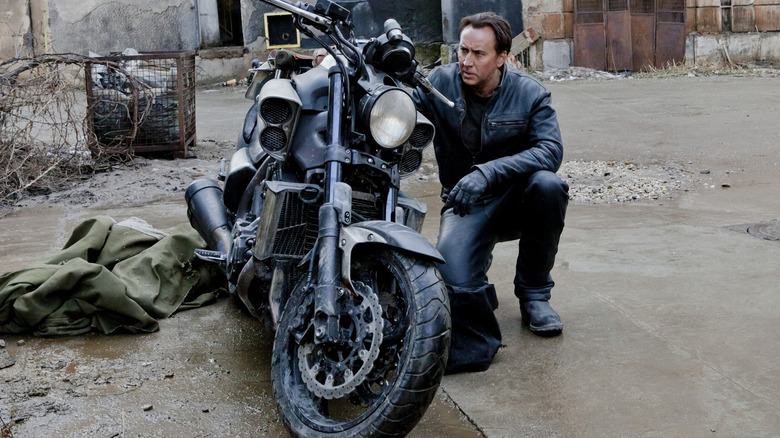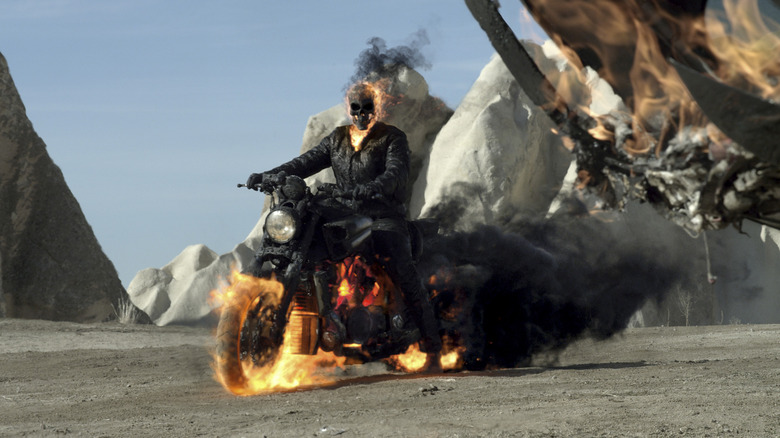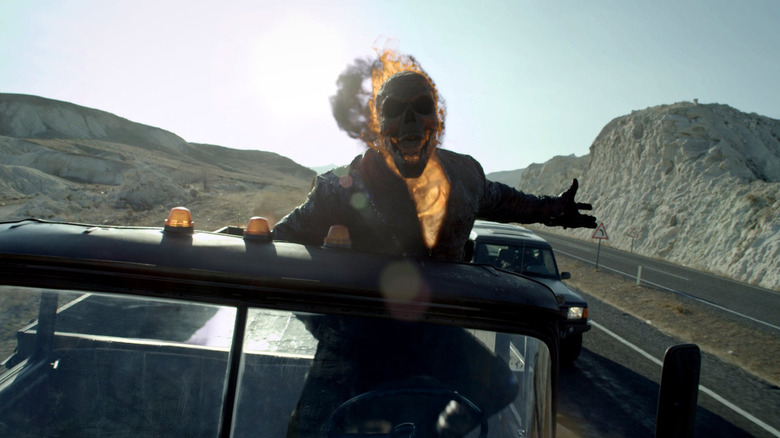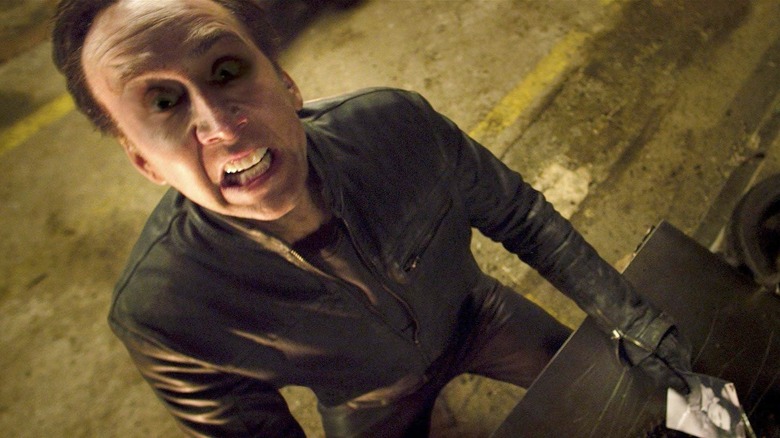Ghost Rider: Spirit Of Vengeance Details That Will Set Your Skull Ablaze
Ghost Rider first appeared in the world of Marvel Comics back in August 1972, in "Marvel Spotlight" #5, and has since become a staple of that fictional universe. By contrast, Ghost Rider has been significantly less prominent in the world of big-screen entertainment. Ghost Rider has only headlined two movies, with the second arriving in 2012 in the form of "Ghost Rider: Spirit of Vengeance." Nicolas Cage reprised his role as Johnny Blaze/Ghost Rider from the 2007 film "Ghost Rider," but "Spirit of Vengeance" was otherwise a wildly different beast compared to what had been established previously. Going in a different direction for this character didn't please critics, but there was still a lot of effort poured into this second stab at a solo "Ghost Rider" feature.
All that work is apparent in various behind-the-scenes aspects of "Ghost Rider: Spirit of Vengeance," which encompasses everything from when this movie was announced to its most arduous production difficulties to even why Nicolas Cage was so committed to playing this particular Marvel superhero, among many other elements. It's doubtful that all these details will turn people who despised "Spirit of Vengeance" into die-hard fans of the film. But it's these details that still capture the immense effort that went into crafting a rare big-screen appearance by this unconventional Marvel crime-fighter.
Ghost Rider 2 was announced before Ghost Rider's debut
Announcing a sequel before the first film in a franchise even opens is a major risk. It's a move that shows major confidence in how a forthcoming feature will perform, but it can also backfire. The likes of "The Mortal Instruments: City of Bones" and "Green Lantern" have all seen their long-in-development plans to get sequels going backfire terribly once those inaugural installments flopped. "Ghost Rider" went down this exact path by having producer Avi Arad deliver a splashy announcement about a sequel being on the way at a press conference for the original film.
In the case of "Ghost Rider," there was a key reason to be optimistic that it would likely spawn a sequel. Even in a world before the Marvel Cinematic Universe, most adaptations of Marvel Comics characters spawned a follow-up, with everything from "Spider-Man" to "Daredevil" to "The Punisher" getting either sequels, spin-offs, or reboots shortly after their releases. With Nicolas Cage in the title role, it wasn't preposterous to assume that "Ghost Rider" could keep that streak alive. In the end, the confidence here was well-placed, as "Ghost Rider" made a decent $229 million worldwide. It wasn't the next "Batman Begins," but "Ghost Rider" had done enough to ensure that a sequel would go ahead after all.
What Nicolas Cage initially wanted for Ghost Rider 2
As it became clear that a "Ghost Rider" sequel was going to be a reality, it was important to assess what leading man Nicolas Cage wanted to achieve by playing this superhero once again. As seen in "National Treasure: Book of Secrets," Cage isn't innately opposed to playing the same character in multiple movies. However, a performer of his ilk wouldn't want to just rehash what he'd done before. The man responsible for such idiosyncratic work in movies ranging from the offbeat "Pig" to the somber "Leaving Las Vegas" would certainly want something new to work with in reprising a specific role.
Talking to MTV in December 2007, Cage expressed excitement over doing a sequel that would explore the darker side of Johnny Blaze/Ghost Rider to reflect how he's embracing, not fighting, his supernatural alter-ego. He also had a hankering for having Ghost Rider face off against newly created villains, as well as a showdown between Ghost Rider and fellow Sony-Marvel superhero Spider-Man. For some actors, doing a blockbuster sequel is an obligation. But Cage's comments indicate that he had ambitious sights for what he could accomplish in playing the Ghost Rider once again.
Casino Royale was a model for this Ghost Rider sequel
At the end of 2009, a "Ghost Rider" sequel was gaining greater and greater creative momentum. Screenwriter David S. Goyer revealed to MTV that this follow-up was far enough along in production to start filming in 2010. He also noted that a concrete creative vision for the film had been established, one that wouldn't reboot the entire saga. However, even if the first "Ghost Rider" wasn't getting ignored, Goyer still saw this sequel as being its own beast. He even invoked how "Casino Royale" changed the game for Bond movies as a model for what he wanted this "Ghost Rider" sequel to be.
Compared to the first movie, Goyer said that this film, much like "Casino Royale" was to previous Bond movies, would be a much darker animal than people expected and contain a degree of realism. Part of this drastic shift from the original "Ghost Rider" would be explained by a significant eight-year time jump in between installments, while Goyer also revealed that this project was being made first and foremost to please people who'd never seen a "Ghost Rider" movie. It can be risky to overhaul everything a franchise is known for, but as "Casino Royale" proved, it can be done, and done incredibly well.
Eva Mendes did not return for Ghost Rider 2
Just as Peter Parker has Mary Jane Watson or Clark Kent has Lois Lane, so too does Ghost Rider's alter-ego Johnny Blaze have a long-term love interest. The character who fulfills that role here is Roxanne Simpson, who was portrayed in the original "Ghost Rider" by Eva Mendes. In other superhero movie franchises, actors who play key love interest characters, like Gwyneth Paltrow or Kirsten Dunst, tend to come back for multiple installments. Despite Simpson being a critical part of Blaze's comic book history, Mendes confirmed in July 2010 that she was not reprising the role in "Ghost Rider: Spirit of Vengeance."
At the time, this could have been seen as another way the new "Ghost Rider" movie was preparing to distance itself from its predecessor. Just as "Spirit of Vengeance" would have a unique tone compared to the first "Ghost Rider," so too would it have a fresh supporting cast. In the context of Eva Mendes's career, however, this seems to have been a turning point. After 2010, Mendes would only have four more credited movie roles before largely retiring from acting. In hindsight, her not coming back for "Ghost Rider: Spirit of Vengeance" seemed to be an early indicator that she was stepping away from the Hollywood limelight. Mendes seems to have had no problem eschewing such projects, even if it left Roxanne Simpson as a weird outlier in the history of superhero movie love interests.
Why is Nicolas Cage so passionate about Ghost Rider?
Nicolas Cage is a big comic book geek. There's no better proof of that than the fact that his chosen last name was inspired by Marvel superhero Luke Cage (via Wired). Beyond that and naming his child Kal-El, Cage has shown his commitment to superheroes through various roles he either played or got super close to tackling, including the titular lead of Tim Burton's "Superman Lives." That makes it no surprise that he ended up portraying Ghost Rider on the big screen, but Cage had a very specific fondness for this character that went beyond just a general love for superheroes.
"Ever since I was a child, I gravitated towards the monsters, be it The Hulk or Ghost Rider," Cage explained to Collider. "I couldn't understand the complexity of something that looked that scary but also was in some way 'good.' To me that already gave it a level of depth that seemed to be missing in some of the other characters." Grappling with that dichotomy instilled in Cage a deep fascination with the world of Ghost Rider, which inspired him to tackle this superhero in live-action form across multiple movies.
Why Cage loved shooting Spirit of Vengeance in Turkey
As another way to differentiate itself from its predecessor, "Ghost Rider: Spirit of Vengeance" was filmed across various parts of Europe. The first "Ghost Rider" was set decidedly in America, complete with several environments meant to evoke backdrops seen in Westerns (complete with a supporting role from Sam Elliott). By contrast, "Spirit of Vengeance" took the Ghost Rider character on a European adventure that made especially heavy use of the country of Turkey. That's not a nation one immediately associates with superhero blockbusters, but it's one that Nicolas Cage saw as absolutely perfect for this motion picture.
Cage told Collider that Turkey was unlike any other place he had ever visited, citing in particular the country's longstanding "cave towns" where inhabitants had lived as far back as 10,000 years earlier. "You're overwhelmed by the alien appearance of it and at the same time, the idea that people were actually living in these places," he marveled. "It's just so ancient." For Cage, that "ancient" quality was a perfect fit for the Ghost Rider, a character who supposedly had existed for centuries on end. Feeding off the aura of a backdrop like Turkey was something that energized Cage as a performer and gave him new places to go with his Ghost Rider performance.
The script changed drastically during production
"Ghost Rider: Spirit of Vengeance" directors Mark Neveldine and Brian Taylor recalled on the Look Back Machine podcast that they were initially attracted to the project by a decidedly R-rated screenplay penned by David S. Goyer. While the two had differing backgrounds in comic book fandom (Taylor loved comics while Neveldine never got into them), both saw this initial script as being in tune with their earlier projects like "Crank." Excited by the prospect of continuing their love for action movie mayhem on a bigger canvas, the duo accepted the gig.
Unfortunately, per Neveldine and Taylor, the screenplay for "Spirit of Vengeance" kept getting drastically overhauled as pre-production pushed on. Eventually, there was little left from Goyer's script in the final product. Worse, the barrage of rewrites had created strange plot elements, such as Satan (Ciaran Hinds) just walking the Earth, that didn't make any sense. Neveldine and Taylor attempted to incorporate little self-winking gags to help mitigate the impact of such storytelling details, but they weren't nearly enough to salvage the script's crushing problems. The initial promise of "Ghost Rider: Spirit of Vengeance" to the directors got flattened out due to the way the screenplay evolved.
How Neveldine and Taylor adapting to shooting a 3D movie
Mark Neveldine and Brian Taylor are well-known for refusing to shoot their movies by conventional means. The duo prefer to stylize their directorial efforts in an attempt to immerse viewers in the chaotic onscreen action. They've been known to hitch themselves to rollerblades while filming a car chase just so the camerawork can be as dynamic as the action sequences. However, "Ghost Rider: Spirit of Vengeance" presented a challenge for this approach, since it was shot in 2D but converted to 3D for theatrical release. It was a reasonable concern that the duo's frantic style of camerawork would end up making viewers sick rather than excited with that extra dimension.
Director Brian Taylor confessed to Collider that knowing that the film would be converted to 3D in post-production did impact how he and Mark Neveldine filmed it. The format didn't work as well with elements like lens flares or fast cuts, two of many visual flourishes that Neveldine and Taylor were accustomed to on earlier features. However, Taylor also expressed excitement over how the team in charge of the movie's post-shoot 3D conversion was planning to implement new technologies and procedures in the film. These practices, theoretically, allowed the majority of Neveldine and Taylor's visual quirks to be maintained, even in the often confining space of digital 3D filmmaking.
Why Nicolas Cage standing in for Ghost Rider was important
It's always a challenge when an actor is tasked with portraying a superhero whose crime-fighting alter-ego can only be brought to life with CGI. There truly are characters who could never be realized through any other resources, but it still means that the actor who audiences spend the majority of the movie with vanishes for some of its biggest set pieces. Such an issue would be especially pressing for "Ghost Rider: Spirit of Vengeance," since Nicolas Cage would disappear whenever the flame-covered Ghost Rider shows up on-screen. Ghost Rider isn't even a costume that can be peeled away to reveal parts of Cage — it's a wholly different organism from Cage's Johnny Blaze.
Director Brian Taylor noted to Collider that he and fellow director Mark Neveldine were insistent that Nicolas Cage portray Ghost Rider on set as often as possible. Referring to the first movie, Taylor recalled how Ghost Rider was once played entirely by stunt people on set. On "Spirit of Vengeance," however, Cage delivered all kinds of physicality and fight choreography that not only allowed him to represent the Ghost Rider character but also reinforced how drastically different this superhero was from Johnny Blaze. Many superhero movies have to deal with the gap between a live-action actor and their all-CGI alter-ego, but "Ghost Rider: Spirit of Vengeance" opted to confront this problem head-on.
Why Spirit of Vengeance was such a challenging shoot
For directors Mark Neveldine and Brian Taylor, countless elements contributed to "Ghost Rider: Spirit of Vengeance" being a challenging movie to film. Constant script changes and a lack of a lengthy pre-production period contributed heavily to their woes, but a big problem was also its expected PG-13 rating. In a pre-"Deadpool" world, the idea of making an R-rated superhero blockbuster was considered a massive risk. As a result, "Spirit of Vengeance" was built from the ground up to be something that could land a softer MPAA rating.
Many blockbuster movie directors would have no trouble working within those confines. Unfortunately, Neveldine and Taylor came from an extreme R-rated background with movies like "Gamer" and the two "Crank" titles. Used to loading up the screen with raunchy material, they had to constantly be aware of not pushing "Ghost Rider" into R-rated territory. Neveldine noted on the Look Back Machine podcast that, once you're making a PG-13 movie, all the creative impulses of the director are at the service of pleasing MPAA restrictions rather than spontaneous inspiration. There was no shortage of problems in the making of "Ghost Rider: Spirit of Vengeance," but keeping it contained to PG-13 was especially arduous.
The mixed box office run of Ghost Rider 2
Arriving five years after the first film, "Ghost Rider: Spirit of Vengeance" was going to need a box office miracle to maintain the financial momentum of its predecessor. Even more pressingly, leading man Nicolas Cage was on a cold streak at the box office, with his two 2011 wide releases failing to crack $25 million domestically. Headlining a superhero movie based on a Marvel Comics character was certainly a much higher-profile project than some of Cage's other star vehicles at the time. However, putting him back in the "Ghost Rider" world wasn't enough for either this actor to bounce back financially or for the "Ghost Rider" franchise to exhibit much strength.
In its worldwide run, "Spirit of Vengeance" made $149.2 million, including $51.7 million in North America. No matter how you look at it, this was a sizeable step down from the financial haul of the first movie and, even on a smaller $57 million budget, didn't suggest "Spirit of Vengeance" would be very profitable in the long term. Waiting so long to make another "Ghost Rider" was a mistake, but it didn't help that "Spirit of Vengeance" was opening just one week after "Safe House." That Denzel Washington hit was the must-see action movie of February 2012 and left "Spirit of Vengeance" in the dust. Though it didn't quite crater at the box office, "Ghost Rider: Spirit of Vengeance" was still a major disappointment.
Ghost Rider 2 ended the franchise
Considering that Sony/Columbia Pictures has released nine different movies headlined by Spider-Man since 2002, it's a foregone conclusion that the studio wasn't aiming to have "Ghost Rider: Spirit of Vengeance" be the definitive end of this superhero franchise. Ideally, "Spirit of Vengeance" would have launched the series in a new direction that the company could exploit for years to come. Unfortunately, the less-than-ideal box office results of "Spirit of Vengeance" made the prospect of doing more big-screen outings with this character a dicey prospect.
Sony ended up abandoning the "Ghost Rider" franchise, ensuring that the character's film rights wouldn't stay with the studio for long. By May 2013, just 15 months after "Spirit of Vengeance" hit theaters, Marvel Studios head Kevin Feige confirmed that the rights to Ghost Rider once again belonged to Marvel, while Nicolas Cage confirmed in August 2013 that he would never play the character again. On paper, "Spirit of Vengeance" aimed to be a movie that revved up the engine of the entire "Ghost Rider" franchise. In execution, though, it ended up inspiring the demise of solo "Ghost Rider" movies for the foreseeable future.
